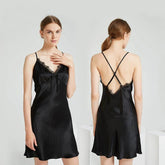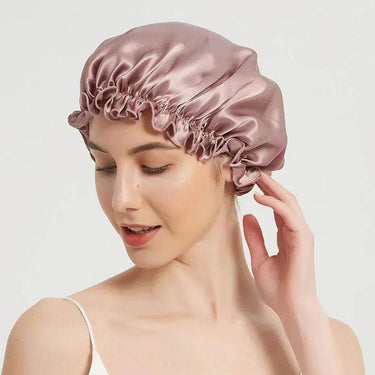Luxury Silk Bonnet – Reduce Frizz & Maintain Healthy Hair
Introduction to Luxury Silk Bonnets
Luxury silk bonnets represent the pinnacle of nighttime hair protection. These specialized head coverings, crafted from premium natural silk fibers, serve as a protective barrier between your hair and external elements during sleep. Unlike conventional hair covers, high-quality silk bonnets provide multiple benefits through their smooth surface and moisture-retaining properties. The difference between an ordinary bonnet and a luxury silk one lies in the material quality, construction techniques, and resulting benefits for hair health. As we explore the world of luxury silk bonnets, you'll discover why these essentials have become indispensable in advanced hair care routines.

Benefits of Luxury Silk Bonnets
Hair Health Benefits
The primary function of silk bonnets centers on protecting and maintaining hair health through multiple mechanisms. Silk creates a frictionless environment that prevents the mechanical damage common with cotton pillowcases or lower-quality head coverings.
Silk bonnets minimize friction through their exceptionally smooth surface, which allows hair strands to glide without catching or snagging. This reduction in friction directly translates to less breakage, split ends, and overall damage to hair shafts. For those with fragile or processed hair, this protection proves particularly valuable in maintaining length and preventing unnecessary damage.
The moisture retention capabilities of silk make these bonnets essential for maintaining proper hair hydration. While cotton and other materials absorb natural oils and moisture from hair, silk preserves this essential hydration. This preservation helps combat dryness, particularly beneficial for curly, coily, and textured hair types that require consistent moisture levels.
Frizz control stands as another significant advantage of silk bonnets. By maintaining consistent humidity levels around hair and reducing the friction that causes cuticle disruption, silk bonnets keep hair smooth throughout the night. Morning frizz becomes minimized, resulting in more manageable hair that requires less styling and heat application.
For those who invest time in creating specific hairstyles, silk bonnets prove invaluable in style preservation. The smooth environment protects curls, waves, blowouts, and set styles, extending their longevity and reducing the need for daily restyling.
Skin Health Benefits
Beyond hair benefits, silk bonnets contribute significantly to skin health, especially for facial skin exposed to the edge of the bonnet.
The skin around the hairline and face maintains better hydration when in contact with silk rather than absorbent materials like cotton. This moisture preservation helps prevent the dryness that often leads to irritation and premature aging signs.
Those with sensitive skin benefit from the hypoallergenic properties inherent in natural silk. The protein structure of silk resists dust mites, mold, and various allergens that commonly trigger skin reactions. Additionally, silk production doesn't require the harsh chemicals often used in synthetic materials, making it less likely to cause contact dermatitis or other skin sensitivities.

Types and Quality of Silk Bonnets
Mulberry Silk Bonnets
Mulberry silk represents the gold standard in silk production, derived from silkworms fed exclusively on mulberry leaves. This specialized diet creates longer, stronger, more uniform silk fibers that result in luxurious fabric with exceptional smoothness and durability.
The quality measurement for silk fabric centers on momme weight—similar to thread count in cotton but specifically designed for silk evaluation. Premium silk bonnets typically feature 19-22 momme weight, providing the ideal balance between durability and lightweight comfort. This measurement indicates the density of silk within the fabric; higher momme counts represent heavier, more durable silk that delivers enhanced protective benefits and longevity.
LANI SILK bonnets feature 22 momme pure mulberry silk, positioning them at the premium end of the silk bonnet spectrum. This higher momme weight translates to enhanced durability, superior moisture retention, and maximized hair protection benefits compared to lower-weight alternatives.
Double-Lined Bonnets
Double-lined silk bonnets represent an advancement in bonnet technology, featuring two layers of premium silk rather than a single layer. This construction method provides enhanced benefits for hair care enthusiasts seeking maximum protection.
The dual-layer design creates superior moisture retention capabilities by establishing a more effective barrier against external elements. This design proves particularly beneficial for those with extremely dry hair or those living in arid climates where moisture preservation becomes crucial.
Additionally, the double-lined construction offers reinforced frizz control through the creation of a more stable microclimate around the hair. This stability translates to more consistent results, particularly for those with textured hair types prone to environmental reactivity.
The increased fabric density of double-lined bonnets provides enhanced durability without sacrificing comfort, making them a wise investment for those seeking long-term hair protection solutions.

Comparison with Other Materials
Silk vs. Satin
Many consumers encounter confusion when choosing between silk and satin bonnets, largely due to marketing that often uses these terms interchangeably despite significant differences between the materials.
| Feature | Pure Silk | Satin |
|---|---|---|
| Composition | Natural protein fiber | Weaving technique using various fibers (often synthetic) |
| Breathability | Highly breathable | Variable, often less breathable than silk |
| Moisture Retention | Superior natural moisture balance | Moderate to poor, depending on materials used |
| Temperature Regulation | Naturally temperature-regulating | Limited regulation capabilities |
| Durability | High with proper care | Variable depending on materials |
| Environmental Impact | Biodegradable natural fiber | Often made from non-biodegradable synthetics |
| Cost | Higher investment | Generally more affordable |
Pure silk consists of natural protein fibers structurally similar to human hair, creating inherent compatibility with hair care. In contrast, satin describes a weaving technique rather than a specific material, often utilizing synthetic fibers like polyester that lack the natural benefits of silk proteins.
The friction coefficient of genuine silk measures significantly lower than that of satin alternatives, providing superior protection against mechanical damage. Silk's natural moisture regulation capabilities outperform satin in maintaining optimal hydration levels for both hair and skin.
While satin bonnets often appeal due to lower price points, the performance difference makes silk the superior choice for those prioritizing hair health and protection.
Silk vs. Cotton
The contrast between silk and cotton bonnets reveals even more dramatic differences in hair protection capabilities.
Cotton, while natural and breathable, possesses a high absorption capacity that actively draws moisture from hair during sleep. This moisture depletion creates compounding dryness issues, particularly problematic for curly, coily, and textured hair types that require consistent hydration.
The surface structure of cotton features tiny hooks and irregularities that catch and snag hair strands, creating significant friction that leads to breakage, split ends, and frizz. This friction proves particularly damaging for fine, fragile, or chemically treated hair.
Cotton lacks the temperature-regulating properties of silk, potentially creating an environment too warm for optimal scalp health. This excess heat may stimulate oil production and disrupt the natural balance of the scalp ecosystem.
For those comparing materials, silk bonnets represent a significant advancement over cotton alternatives for serious hair protection and maintenance.

Usage Tips and Tricks
Maximizing the benefits of your luxury silk bonnet requires proper usage techniques tailored to your specific hair type and concerns:
- Preparation: Begin with detangled hair to prevent overnight knotting. For curly or textured hair, apply appropriate leave-in products before donning your bonnet.
- Placement: Position the bonnet to cover all hair completely, with the elastic band secure but not tight enough to cause compression or discomfort.
- Containment: Ensure all hair strands remain within the bonnet throughout the night. Those with longer or voluminous hair may benefit from loosely gathering hair at the crown before covering.
- Removal: Remove the bonnet gently in the morning by rolling it backward rather than pulling forward, which minimizes friction and potential damage.
- Maintenance: Hand wash your silk bonnet with mild, pH-balanced soap in cool water every 7-10 days, depending on product usage and perspiration levels. Allow to air dry away from direct sunlight.
For those with curly hair, additional techniques enhance bonnet effectiveness:
- Pineapple your curls (loosely gather at the crown) before applying the bonnet for volume preservation
- Consider using the "medusa method" for tighter curl patterns, separating hair into multiple loose sections before covering
- Apply appropriate moisture products before covering to maximize the silk bonnet's ability to seal in hydration overnight

Product Recommendations
When selecting a luxury silk bonnet, several key features distinguish premium options from basic alternatives:
LANI SILK's Pure Mulberry Silk Bonnet offers exceptional quality with 22 momme weight, reinforced elastic that prevents hair disturbance, and double-lined construction for maximum protection. The adjustable fit accommodates various hair volumes while maintaining comfort throughout the night.
Across the luxury silk bonnet market, brands vary significantly in silk quality, construction methods, and design features. Premium options typically offer:
- Certified pure mulberry silk with momme weights of 19-22
- Reinforced, covered elastic that prevents damage while maintaining position
- Thoughtful sizing options accommodating different hair volumes and types
- Quality construction with attention to seam placement to prevent hair disturbance
- Ethical production practices with transparent supply chains
While investment prices for quality silk bonnets range from $45-85, this cost reflects the substantial quality difference compared to synthetic alternatives priced below $20. The performance benefits and longevity of premium silk make these bonnets cost-effective long-term investments in hair health.

Expert Insights and Reviews
Hair care professionals increasingly recommend silk bonnets as essential elements in comprehensive hair protection regimens. Celebrity hairstylist James Thompson notes, "The difference between clients who protect their hair with quality silk overnight and those who don't becomes immediately visible in hair integrity and style longevity."
Dermatologists specializing in hair and scalp health emphasize the benefits beyond aesthetics. Dr. Michelle Chen, board-certified dermatologist, states, "The reduction in friction from silk bonnets translates to measurable decreases in breakage and mechanical damage, particularly beneficial for those with fragile hair conditions."
Customer experiences reflect these professional observations. Sarah L., a verified LANI SILK customer, reports, "After three months of consistent use, my hair breakage decreased significantly, and my curls maintain definition for days rather than hours." Another customer notes, "The difference between my previous satin bonnet and this pure silk one proved immediately noticeable in morning frizz reduction."
Conclusion
Luxury silk bonnets represent an investment in hair health that delivers measurable benefits through superior protection against friction, moisture loss, and environmental factors. The natural properties of high-quality mulberry silk create an optimal environment for hair during the vulnerable sleep hours when mechanical damage often occurs. By incorporating a premium silk bonnet into your nighttime routine, you establish a foundation for healthier, more manageable hair with reduced breakage, improved moisture retention, and enhanced style longevity. This simple yet effective addition to your hair care regimen offers both immediate results and long-term benefits for hair integrity and appearance.
Frequently Asked Questions
What momme weight provides the best protection in silk bonnets? For optimal hair protection, select silk bonnets with 19-22 momme weight. This range delivers the ideal balance between durability and lightweight comfort, with higher momme counts within this range providing enhanced moisture retention and longevity.
How frequently should I wash my silk bonnet? Hand wash your silk bonnet every 7-10 days using mild, pH-balanced soap in cool water. Those using styling products or experiencing higher perspiration levels may benefit from more frequent cleaning. Always air dry away from direct sunlight to preserve silk integrity.
Are silk bonnets appropriate for all hair types? Silk bonnets benefit all hair types through friction reduction and moisture preservation. However, different hair textures may require specific bonnet sizes or styles: those with voluminous curly or coily hair benefit from roomier designs, while those with fine or straight hair may prefer more fitted options.
How do I determine whether to choose silk or satin for my hair protection needs? Pure silk provides superior benefits through its natural protein structure, moisture balance, and ultra-low friction coefficient. Satin, typically made from synthetic materials, offers a more affordable alternative but lacks the natural properties that make silk exceptionally compatible with hair care. Those prioritizing maximum protection should invest in genuine silk, while those with budget constraints might begin with satin while saving for a silk upgrade.
Future of Silk Bonnets in Hair Care

The silk bonnet market continues evolving with innovative designs addressing specific hair concerns beyond basic protection. Recent developments include compartmentalized bonnets that separate and protect different curl patterns within the same head of hair, targeted moisture zones for those with varying hydration needs across their hair, and antimicrobial silk treatments that extend product cleanliness between washings.
Sustainability advancements in silk production show promise for environmentally conscious consumers. Peace silk (also called ahimsa silk) allows the silkworm to complete its lifecycle rather than harvesting the cocoon before moth emergence. While this method produces slightly different silk characteristics, technological improvements continue narrowing the performance gap between traditional and peace silk options.
The integration of silk bonnets into mainstream hair care signals a shift toward preventative hair health measures rather than merely corrective treatments. This holistic approach acknowledges the importance of protection during vulnerable sleep hours as foundational to overall hair health and appearance.




























